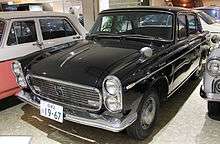Isuzu Bellel
| Isuzu Bellel | |
|---|---|
 1964 Bellel 2000 Deluxe | |
| Overview | |
| Manufacturer | Isuzu |
| Production | 1961–1967 |
| Assembly | Fujisawa Plant, Fujisawa, Kanagawa, Japan |
| Body and chassis | |
| Class | compact |
| Body style |
4-door sedan 4-door station wagon |
| Powertrain | |
| Engine |
1.5 L GL150 I4 2.0 L I4 1999 cc DL200 diesel I4 1991 cc DL201 diesel I4 |
| Transmission | 4-speed manual |
| Dimensions | |
| Wheelbase | 2,530 mm (100 in) |
| Length |
4,485 mm (176.6 in) wagon 4,470 mm (176 in) sedan |
| Width | 1,690 mm (67 in) |
| Height |
1,500 mm (59 in) 1,515 mm (59.6 in)sedan |
| Curb weight |
1,190 kg (2,620 lb) 1,295 mm (51.0 in)wagon |
| Chronology | |
| Predecessor | Isuzu Hillman Minx |
| Successor | Isuzu Florian |
The Isuzu Bellel was a compact car produced by the Japanese automobile manufacturer Isuzu between 1961 until 1966. It was the company's first independent design, and also Japan's first passenger car with a diesel engine. It was available as a four-door sedan and a five-door station wagon, called the Bellel Express. The name "Bellel" resulted from combining the English word "bell" with the Roman numeral "L", equalling 50, and thus the name was supposed to represent "fifty Bells" (Isuzu literally means "fifty bells" in Japanese). Production began in time for the 1964 Summer Olympics held in Tokyo in October 1964.
The Bellel was fitted with 1.5 L and 2.0 L gasoline OHV engines, and also the aforementioned 55 PS (40 kW) 2.0 L diesel (DL201) engine.[1] The original diesel engine was called the DL200; it offered 52 PS (38 kW). All engines were mated with a four-speed manual transmission with the shifter mounted on the steering column. The suspension setup was modeled after the Hillman Minx, which was previously manufactured by Isuzu under a license agreement with the Rootes Group.
The original end treatment was updated in October 1965 in an attempt to afford the Bellel a more formal, upscale and mainstream look. The facelift included changes to the front fascia, where the previous single round headlights paired with smaller turn signals were replaced by quad round headlights arranged vertically.

The diesel engine - a first for a Japanese passenger car - made the Bellel popular for commercial applications, such as taxicab services.[2] This partially helped to offset the Bellel's relative unpopularity with private customers, which resulted from the harshness of the early diesel engine and peculiar styling. A small number of these cars found their way into other countries, with left-hand drive. 37,206 Bellels were manufactured in total, with production coming to an end in May 1967.
References
- ↑ James M. Flammang (1994). Standard Catalog of Imported Cars, 1946-1990. Iola, WI: Krause Publications, Inc. p. 308. ISBN 0-87341-158-7.
- ↑ "Isuzu Bellel PSD10". 240 Landmarks of Japanese Automotive Technology. Society of Automotive Engineers of Japan Inc. Retrieved 2014-01-04.
External links
- An essay on the Bellel in Japanese
- Images of Isuzu Bellel
- Pre-facelift Bellels for sale (notice the triangular taillights)
- 1964 Bellel's role as a taxi in the 1966 movie "What's Up, Tiger Lily?"
| Isuzu international road car timeline, 1950s–1970s — next » | |||||||||||||||||||||||||||
|---|---|---|---|---|---|---|---|---|---|---|---|---|---|---|---|---|---|---|---|---|---|---|---|---|---|---|---|
| Type | 1950s | 1960s | 1970s | ||||||||||||||||||||||||
| 3 | 4 | 5 | 6 | 7 | 8 | 9 | 0 | 1 | 2 | 3 | 4 | 5 | 6 | 7 | 8 | 9 | 0 | 1 | 2 | 3 | 4 | 5 | 6 | 7 | 8 | 9 | |
| Subcompact car | Gemini | ||||||||||||||||||||||||||
| Compact car | Bellett | ||||||||||||||||||||||||||
| Minx | Minx | 117 Coupé | 117 Coupé | 117 Coupé | |||||||||||||||||||||||
| Bellel | Florian | Florian SII | |||||||||||||||||||||||||
| Full-size | Statesman de Ville | ||||||||||||||||||||||||||
| Compact pickup | Wasp | Faster / TF | |||||||||||||||||||||||||
| Compact SUV | Unicab | ||||||||||||||||||||||||||